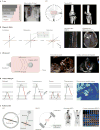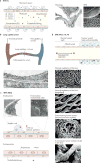Towards clinically translatable in vivo nanodiagnostics
- PMID: 29876137
- PMCID: PMC5985817
- DOI: 10.1038/natrevmats.2017.14
Towards clinically translatable in vivo nanodiagnostics
Abstract
Nanodiagnostics as a field makes use of fundamental advances in nanobiotechnology to diagnose, characterize and manage disease at the molecular scale. As these strategies move closer to routine clinical use, a proper understanding of different imaging modalities, relevant biological systems and physical properties governing nanoscale interactions is necessary to rationally engineer next-generation bionanomaterials. In this Review, we analyse the background physics of several clinically relevant imaging modalities and their associated sensitivity and specificity, provide an overview of the materials currently used for in vivo nanodiagnostics, and assess the progress made towards clinical translation. This work provides a framework for understanding both the impressive progress made thus far in the nanodiagnostics field as well as presenting challenges that must be overcome to obtain widespread clinical adoption.
Keywords: Physical sciences / Engineering / Biomedical engineering [URI /639/166/985]; Physical sciences / Materials science / Nanoscale materials [URI /639/301/357]; Physical sciences / Nanoscience and technology / Nanomedicine [URI /639/925/352]; Physical sciences / Nanoscience and technology / Nanoscale materials [URI /639/925/357].
Conflict of interest statement
Competing interests statement The authors declare no competing interests.
Figures





References
-
- Cairns J. The treatment of diseases and the war against cancer. Sci Am. 1985;253:51–59. - PubMed
-
- Nestor PJ, Scheltens P, Hodges JR. Advances in the early detection of Alzheimer’s disease. Nat Med. 2004;10(Suppl):S34–S41. - PubMed
-
- Greish K. Enhanced permeability and retention (EPR) effect for anticancer nanomedicine drug targeting. Methods Mol Biol. 2010;624:25–37. - PubMed
-
- Lee DE, et al. Multifunctional nanoparticles for multimodal imaging and theragnosis. Chem Soc Rev. 2012;41:2656–2672. - PubMed
-
- Anker JN, et al. Biosensing with plasmonic nanosensors. Nat Mater. 2008;7:442–453. - PubMed
Grants and funding
LinkOut - more resources
Full Text Sources
Other Literature Sources
Research Materials
